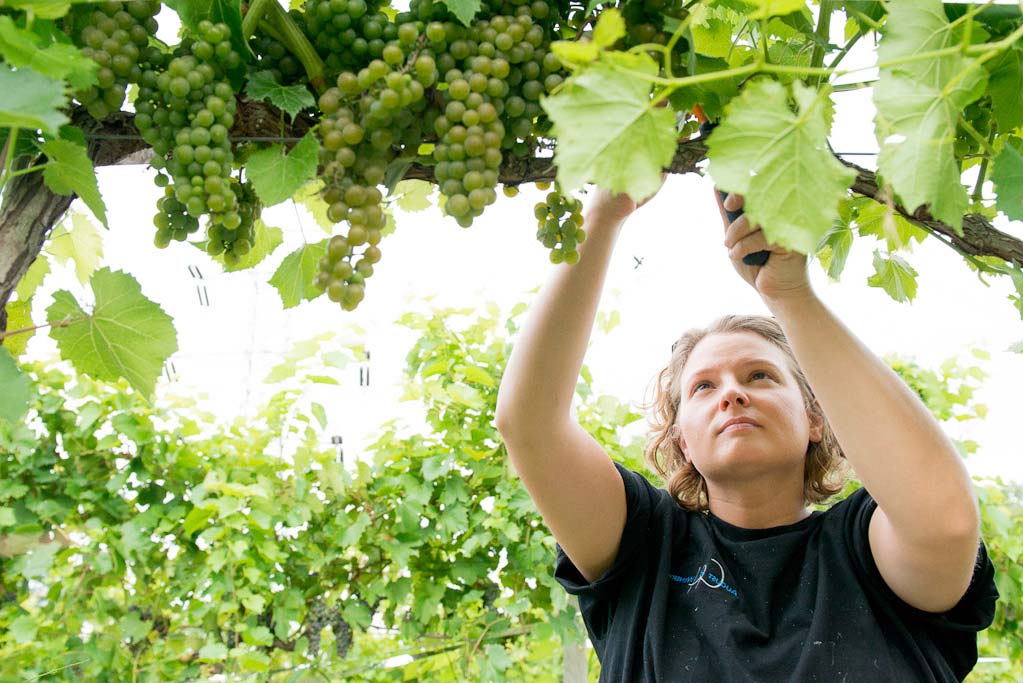The grapes that we use in our sparkling wines are French-hybrid grapes, and they have a unique history.
In the mid-1800’s, our friends across the pond were dealing with “The Great French Wine Blight” and boy did it cause some excitement in France. It was all caused by a tiny Phylloxera aphid that traveled from America to France and destroyed over 40% of the French grape vines over a 15-year period. One of the solutions they came up with to deal with the Phylloxera was hybridization. Hybridization of plants is when you pollinate one plant species with the flower of another one. Grape hybrids are the cross-breeding of two different varieties of wild, naturally evolved grape vines. The French brought in American grape varieties that were resistant to Phylloxera and cross-bred these grapes with European wine grapes giving us French-hybrid grapes.
Although French-American hybrid grapes were originally created to resist Phylloxera, they also had a quality that was important to American grape growers, especially those living in the northern states: these hybrids could withstand the extreme cold temperatures making them perfect for our climate here in Illinois.
Since the original creation of the French-hybrids in France, American viticulturists from places like Cornell and the University of Minnesota have created additional hybrids that make great wines. The great news for all wine lovers is that they continue to experiment and come up with new ideas every year.
Here’s a look at the French-hybrid grapes that are used to make Illinois Sparkling Co. Traditional Method sparkling wines:
Chambourcin
The Chambourcin grape’s background is clouded in mystery. We do know that this hybrid was created by Joannes Seibel in the Loire Valley of France and is based on a number of Native American species and Seibel hybrids. Chambourcin was created in the 1860s, but was not used commercially here in the U.S. until 1963. We pick these grapes between 18-20 brix, giving the base wine nice clean and crisp flavors of light red fruit of strawberries. The secondary fermentation in the bottle integrates and brings in notes of honey, minerality, cocoa, and vanilla. We use this grape to make Brut Ombré Rosé.
Marquette
The Marquette grape is a cold hardy, red wine grape variety named after Pere Marquette, a 17th century explorer in North America. Patented by the University of Minnesota in 2006, Marquette is a cousin of Frontenac and a grandson of Pinot Noir.
Marechal Foch
Marechal Foch has conquered the cold climates of North America just like its namesake from France, General Foch, who marched triumphantly through Champagne in the Battle of Marne. This French-American hybrid, developed in France by Eugene Kuhlmann, is often considered to possess Burgundian characteristics, having a vibrant, deep purple color, with a light-medium structure and dark berry fruit characteristics. We use this grape to make Brut Rosé de Saignée.
La Crescent
Developed by Peter Hemstad and James Luby at the University of Minnesota, La Crescent is another one of the hybrids that can handle extreme cold – withstanding temperatures as low as -36 F. La Crescent is the result of a St. Pepin x Swenson cross. La Crescent is the most aromatic of all the grapes we use for sparkling wine. We get an apricot and a hint of oxalis (edible clover) with the initial wine. Because of the great aromatics of apricot, we continue to get apricot and peach while aging on yeast as well as a hint of the oxalis, and a very slight note of yeast. We use this grape to make Sec.
Frontenac
Frontenac is a tough grape, ready to take on polar vortex conditions. Born in Minnesota, this red wine grape is a cross of the French-America hybrid, Landot 4511, and the American native, Vitis ripara. For sparkling wine we harvest these grapes earlier than the the grapes we use for still wines. We process using the saignee method of crushing the grapes and then letting the juice bleed out of the press without physically pressing the grapes. This method has allowed the fruit to show a great cherry aroma and flavor with bright acidity, low tannins, and a great rose color. The secondary fermentation in the bottle brings in a cherry pie aromatics and a little cocoa. We use this grape to make Demi Sec Rosé.
Frontenac Gris
Frontenac gris is a white wine version of Frontenac, introduced in 2003. It started as a single bud mutation of Frontenac, yielding gray (thus named gris) fruit and amber-colored juice with a great acidity and mid-palate structure. This is a grape we really like and is used in our Brut as more vines are coming into production. We whole-berry press this grape and the juice comes out clear with very subtle tones of citrus, floral, minerality, and grass. Aging in the bottles, we develop honey, minerality, vanilla, and baker’s yeast.
Frontenac Blanc
Frontenac blanc was introduced in 2012 from white-fruited mutations found in both Frontenac and Frontenac Gris vines in Minnesota and Canada. Similar to its Frontenac cousins, it can withstand temperatures down to -36°F. Like Frontenac Gris, the vine looks identical to Frontenac. Interestingly, however, Frontenac Blanc produces wines that are distinctly different form Frontenac Gris in flavor and aroma.
